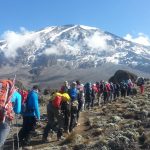When is the Best Time to Climb Kilimanjaro?
We generally advise that the best time to climb Kilimanjaro is during the warmest and driest times of year, from December to mid-March and mid-June to the end of October. However, although these are considered to be the best times to climb the mountain in terms of weather, they are also the busiest months.
Mount Kilimanjaro’s proximity to the equator, this region does not experience the extremes of winter and summer weather, but rather dry and wet seasons. Therefore, the best time to climb Kilimanjaro tends to be the warmest and driest months (see weather on Kilimanjaro).
The primary concerning is safety, as the risks associated with climbing increase significantly when the weather is foul. The effects of rain, mud, snow, ice and cold can be very strenuous on the body. Correspondingly, your chances of a successful summit also increases significantly with nice weather. Of course, the mountain gets more foot traffic during these periods as well.
Can a beginner climb Kilimanjaro?
Can an unfit person climb Kilimanjaro?
Who should not climb Kilimanjaro?
When not to climb Kilimanjaro?
What is the danger of Kilimanjaro?
This is the steepest section of any Kilimanjaro route by far, and requires some scrambling. You only tackle Barranco Wall on the Shira, Lemosho, Machame and Umbwe routes. If you’re not keen for this steep climb, we recommend climbing the Northern Circuit, Rongai or Marangu route.
Why is Kilimanjaro so expensive?

Summit During a Full Moon
Some climbers prefer to summit during a full moon.
When the peak of Kilimanjaro and magnificent glaciers are lit up by the full moon, the view is absolutely stunning. For this reason alone, some climbers schedule their trek to coincide with this celestial event, occurring once a month. However, a practical reason for climbing at these times is that a bright moon along with a clear sky will improve your visibility throughout your climb, and most importantly, during the summit attempt. Below are full moon dates:
Kilimanjaro Full moon and weather, Firstly you’ll be accompanied and guided in your night-time trek by the bright light of the full moon. It illuminates your six-hour journey up to Uhuru Peak, making the glaciers glitter and the rolling clouds below you glow. The moonlight also makes the earth beneath your feet glisten. Sounds like a dream, right?
Secondly, a practical reason for climbing during a full moon is that its brightness (when paired with a clear sky) improves visibility throughout your Kilimanjaro trek, especially during your summit attempt.
Thirdly, climbing Kilimanjaro during a full moon offers you magnificent night views of Kibo from most of the overnight camps. So to summarize, a full moon offers:
- stunning views
- improved visibility during summit attempt
- views of Kibo from most camps
A full moon therefore makes what’s already a very special trip just that little bit more special. The full moon is widely considered one of the best times in the month to climb Kilimanjaro. As to which month is the best month to climb?
Kilimanjaro Full Moon Dates 2023, 2024
| Month | Year 2023 | Year 2024 |
|---|---|---|
| January | 28th | 17th |
| February | 27th | 16th |
| March | 28th | 18th |
| April | 27th | 16th |
| May | 26th | 15th |
| June | 24th | 14th |
| July | 24th | 13th |
| August | 22nd | 11th |
| September | 21st | 10th |
| October | 20th | 9th |
| November | 19th | 8th |
| December | 19th | 7th |








